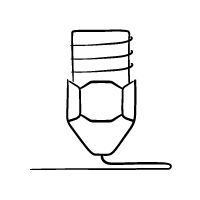ABS
ABS filament, or Acrylonitrile Butadiene Styrene, is a commonly used material for 3D printing. ABS is a relevant one when you look at parts that need to be heat resistant at a cheap price. ABS is made from petroleum products and has a strong and durable structure.
Ease of use
Strength




Extruder
220-250 °C
Other than brass nozzle is recommended


Pray
95-110 °C
Heating of Bed or Enclosure is required


Cooling
0%
Not necessarily
When is ABS used?
Acrylonitrile Butadiene Styrene (ABS) has established itself as an important material in 3D printing. Its strong and durable properties have made it a popular choice for many applications. ABS material is known for its ability to maintain structural integrity even under stress, making it useful for components that require resistance to mechanical stress and wear. In addition, ABS is known for its good chemical resistance to various substances and for its ability to withstand temperature variations, which opens the door for use in various environments.
In addition to its technical properties, ABS material is also widely used in various industries and applications. It is widely used in the automotive industry for the manufacture of interior parts and structural components. In household products, ABS materials include the manufacture of toys, household appliances and other everyday items. Its usability and reliability have made it a tangible player in the 3D printing community and an important resource for enabling creative and functional design solutions.
Advantages
- Cheap
- Abrasion resistant
- Heat resistant
Disadvantages
- Warping
- Smell strong
- Tends to shrink
Tip
- Automotive Parts: ABS is widely used for manufacturing automotive parts such as dashboards, consoles and panels due to its durability and heat resistance.
- Tools and machine components: Mechanical components, fasteners and special tools can be created with ABS thanks to its strength and durability.
Print speed: Use a moderate print speed to ensure accuracy and maintain high quality output.
Layer Height (Layer Height): Choose an appropriate layer height depending on your project – less layer height gives a more detailed and smooth surface. Retraction: Fine-tune the retraction settings to minimize wire strands and impurities, resulting in a cleaner and more accurate print.
The adhesion of the building plate: Improve adhesion by using special coatings such as kapton tape or a heated build plate to ensure the print adheres properly and prevent warping or loss of adhesion.
Humidity control: Store the ABS material in a dry and sealed storage solution to prevent moisture absorption and preserve the quality of the material over time.
ABS vs ABS+
| Feature | ABS | ABS+ |
|---|---|---|
| Material composition | Acrylonitrile Butadiene Styrene | Modified Acrylonitrile Butadiene Styrene |
| Strength | ● ● ● | ● ● ● |
| Flexibility | Rigid | Slightly Flexible |
| Printability | ● ○ ○ | ● ○ ○ |
| Surface Finish | Standard | Improved |
| Layer Adhesion | ● ● ○ | ● ● ● |
| Temperature Resistance | ● ● ● | ● ● ● |
| Applications | Functional Parts, Prototypes | Mechanical Components, Prototypes |
*In relation to each other